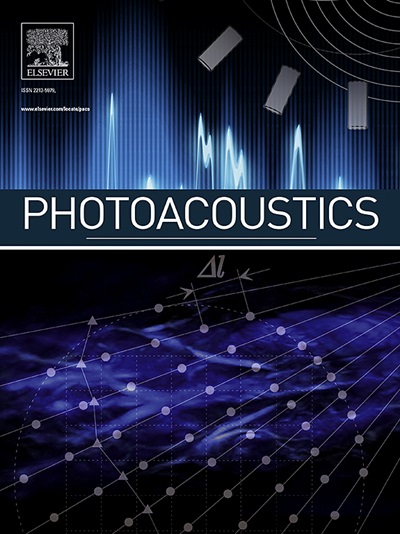Use of pattern recognition in photoacoustic imaging to identify neuronal ensembles in the prefrontal cortex of rats undergoing conditioned fear learning
IF 7.1
1区 医学
Q1 ENGINEERING, BIOMEDICAL
引用次数: 0
Abstract
Pattern recognition analysis in brain research has improved understanding of sensory processing and led to the identification of default brain networks in neuroimaging studies. The current study uses pattern recognition analysis to extend our previous findings showing conditioned fear learning and novelty-exposure (i.e. sham conditioning) equally increase Fos-dependent neuronal ensemble signal intensity in the prefrontal cortex (PFC) of rats as quantified by photoacoustic imaging (e.g. functional/molecular photoacoustic tomography). Here we use similarity metrics-based pattern recognition analysis to determine if neuronal ensemble activation patterns in the PFC are unique fear-conditioned compared to sham-conditioned rats. Our results show that a qualitatively-unique pattern in signal intensity exists only for the fear-conditioned group compared to sham-conditioned, behaviourally-naïve, or fear-conditioned vehicle control groups. These findings suggest that while the PFC is involved equally in novelty-exposure and fear learning, only highly coordinated behavioral tasks engage the PFC in a homogenous pattern of activity. This study also highlights the use of pattern recognition analysis using photoacoustic imaging data leading the way for future use of this computational approach to brain imaging.
利用光声成像中的模式识别识别大鼠进行条件恐惧学习的前额叶皮层中的神经元群。
大脑研究中的模式识别分析提高了人们对感觉处理的理解,并在神经影像学研究中发现了默认大脑网络。本研究利用模式识别分析扩展了我们之前的发现,即条件性恐惧学习和新奇事物暴露(即假条件反射)同样会增加大鼠前额叶皮层(PFC)中依赖于 Fos 的神经元集合信号强度,并通过光声成像(如功能/分子光声断层扫描)进行量化。在这里,我们使用基于相似度量的模式识别分析来确定前额叶皮层的神经元集合激活模式与假条件大鼠相比是否具有独特的恐惧条件。我们的研究结果表明,与假性调理组、行为未受调理组或恐惧调理车辆对照组相比,只有恐惧调理组存在定性的独特信号强度模式。这些研究结果表明,虽然前脑功能区同样参与了新奇暴露和恐惧学习,但只有高度协调的行为任务才会使前脑功能区参与同质的活动模式。这项研究还强调了使用光声成像数据进行模式识别分析的重要性,为今后使用这种计算方法进行脑成像提供了新的思路。
本文章由计算机程序翻译,如有差异,请以英文原文为准。
求助全文
约1分钟内获得全文
求助全文
来源期刊

Photoacoustics
Physics and Astronomy-Atomic and Molecular Physics, and Optics
CiteScore
11.40
自引率
16.50%
发文量
96
审稿时长
53 days
期刊介绍:
The open access Photoacoustics journal (PACS) aims to publish original research and review contributions in the field of photoacoustics-optoacoustics-thermoacoustics. This field utilizes acoustical and ultrasonic phenomena excited by electromagnetic radiation for the detection, visualization, and characterization of various materials and biological tissues, including living organisms.
Recent advancements in laser technologies, ultrasound detection approaches, inverse theory, and fast reconstruction algorithms have greatly supported the rapid progress in this field. The unique contrast provided by molecular absorption in photoacoustic-optoacoustic-thermoacoustic methods has allowed for addressing unmet biological and medical needs such as pre-clinical research, clinical imaging of vasculature, tissue and disease physiology, drug efficacy, surgery guidance, and therapy monitoring.
Applications of this field encompass a wide range of medical imaging and sensing applications, including cancer, vascular diseases, brain neurophysiology, ophthalmology, and diabetes. Moreover, photoacoustics-optoacoustics-thermoacoustics is a multidisciplinary field, with contributions from chemistry and nanotechnology, where novel materials such as biodegradable nanoparticles, organic dyes, targeted agents, theranostic probes, and genetically expressed markers are being actively developed.
These advanced materials have significantly improved the signal-to-noise ratio and tissue contrast in photoacoustic methods.
 求助内容:
求助内容: 应助结果提醒方式:
应助结果提醒方式:


